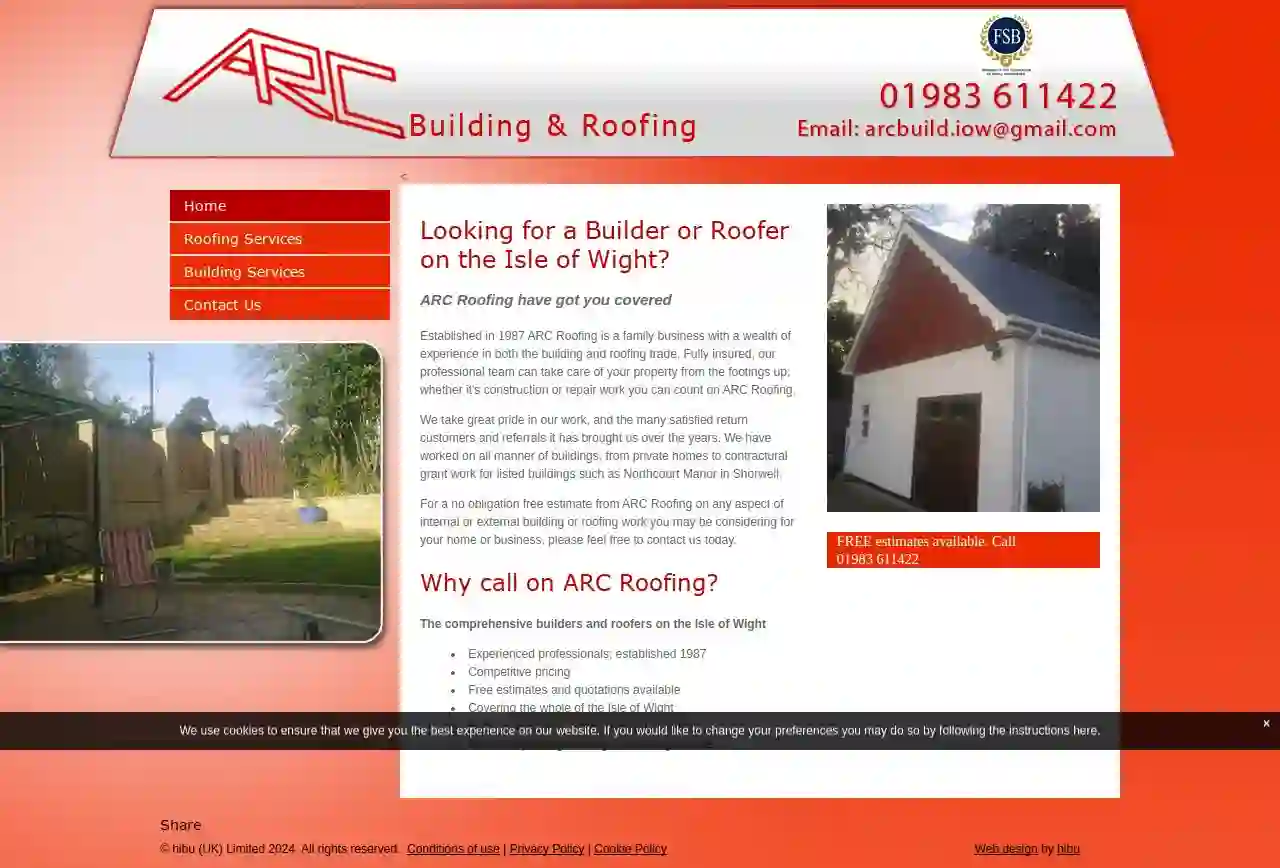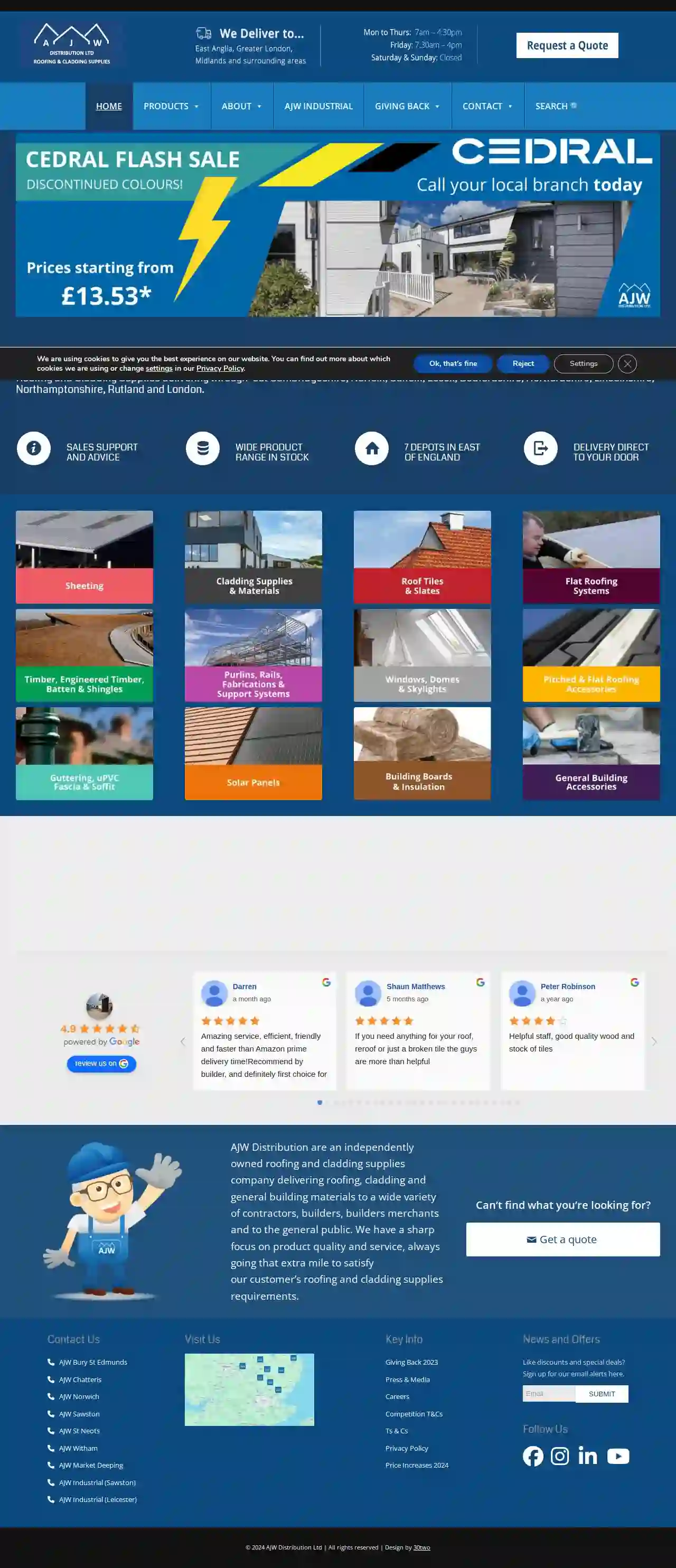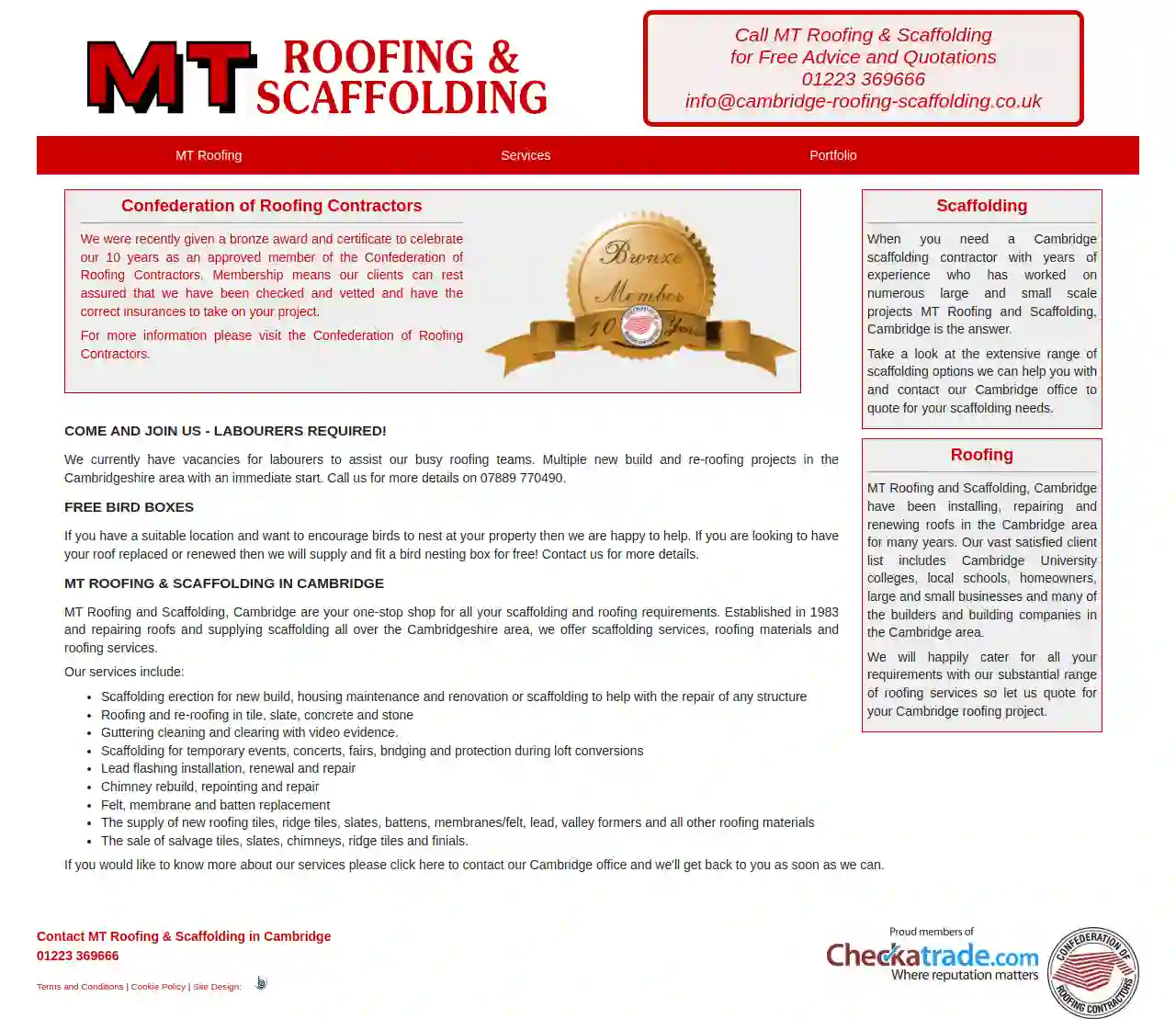Roofing Companies Shelford
Best Roofing Service in Shelford
Receive 3 FREE Roofing Contractor quotes for your project today! Compare profiles, reviews, accreditations, portfolio, etc... and choose the best service.

Camclad Contractors Ltd
4.611 reviewsStirling Way, Unit 10 Papworth Business Park, Cambridge, CB23 3GY, GBCamclad has over 40 years combined experience, creating high quality cladding, refurbishment and new build services for commercial and industrial clients. We are friendly and flexible, willingly undertaking jobs of all sizes; from cleaning out gutters and gullies to installing detailed envelopes on large buildings, budgets ranging from £500.00 to £2,000,000.00. Camclad has over 40 years combined experience of high quality, long lasting cladding repair, refurbishment and new build services for industrial, commercial and retail buildings. Before considering any alterations to your building, ask for our free expert advice on choosing materials and best-practice repair or refurbishment work that will restore your building to be as good as new and save you time and money.
- Services
- Why Us?
- Accreditations
- Gallery
Get Quote
Arc Roofing & Building
55 reviews22 Newnham Road, Ryde, PO33 3TE, GBEstablished in 1987, ARC Roofing is a family-run business with a wealth of experience in both the building and roofing trade. Fully insured, our professional team can take care of your property from the footings up; whether it's construction or repair work, you can count on ARC Roofing. We take great pride in our work, and the many satisfied return customers and referrals it has brought us over the years. We have worked on all manner of buildings, from private homes to contractural grant work for listed buildings such as Northcourt Manor in Shorwell. For a no-obligation free estimate from ARC Roofing on any aspect of internal or external building or roofing work you may be considering for your home or business, please feel free to contact us today. Why call on ARC Roofing? The comprehensive builders and roofers on the Isle of Wight Experienced professionals; established 1987 Competitive pricing Free estimates and quotations available Covering the whole of the Isle of Wight Fully insured, with public liability insurance All-encompassing building and roofing service
- Services
- Why Us?
- Gallery
Get Quote
Roof-Fix Building
GBCambridgeshire Roofing Network is a network of roofing professionals serving Murrow and surrounding areas. They offer a wide range of roofing services for both residential and commercial clients, including roof repairs, flat roofing, guttering, fascias & soffits, and more. The network emphasizes the importance of a well-built roof and highlights the potential damage that even small leaks can cause. They encourage homeowners to contact them for a free quote and advice on the condition of their roof. The network also promotes environmentally friendly roofing solutions like EPDM rubber roofing, citing its longevity and reduced environmental impact compared to PVC membranes.
- Services
- Why Us?
- Gallery
Get Quote
AJW Distribution 'Roofing and Cladding Supplies' (Sawston) Ltd
4.631 reviewsChatteris (HQ), what3words: slap.spearhead.frames, Units 6 & 7 Honeysome Industrial Estate, Honeysome Road, Chatteris, PE16 6TG, GBAJW Distribution Ltd – Where service comes first. Roofing and Cladding Supplies delivering through-out Cambridgeshire, Norfolk, Suffolk, Essex, Bedfordshire, Hertfordshire, Lincolnshire, Northamptonshire, Rutland and London.
- Services
- Why Us?
- Accreditations
- Our Team
- Testimonials
- Gallery
Get Quote
Ark roofers ltd
55 reviewsCambridge, GB- Services
- Why Us?
- Gallery
Get Quote
Ely Roofing Company
4.766 reviewsEly, GBWelcome to Ely Roofing Company, an Ely based roofing firm offering all aspects of roofing services, such as flat roofs, pitched roofs, roof repairs, roof renovation, fascias, soffits, guttering and cladding throughout Cambridgeshire. Ely Roofing Company is an experienced family run roofing company in Ely, Soham and Cambridgeshire with over 35 years experience. Our specialist team of roofers in Ely are fully trained and qualified in all aspects of roofing. We offer free consultation and deliver free estimates to ensure that the correct roofing solution has been selected based around your project requirements, size and budget. Based in Ely, our team of roofing contractors are able to complete all aspects of residential roofing services for any type and size of project. We know how important it is to offer a flexible service and are always more than happy to help you find that perfect roofing solution to ensure we maintain our 5 star reputation with customer reviews throughout our working locations.Our roofing specialists can provide all aspects of roofing services, including pitched roofs, flat roofs, roof repairs, roof renovation, cladding, fascias, soffits and guttering. Finding roofers in Ely is easy but finding roofers you can trust to provide high quality roofing services is easier said than done. The Ely Roofing Company team are always ready and waiting to help you. Here at Ely Roofing Company, our friendly and professional roofers can provide all roofing services throughout Ely, Soham and Cambridgeshire. Our roofing contractors have over 35 years experience and can help with completely new roof installations to small roof repairs, no job is too big or small. We always strive to provide each and every one of our clients with the most high quality and transparent roofing solutions possible. Exceeding customer expectations for both quality of work and customer service is very important and has helped us gain an excellent reputation for roofers in Ely.Our roofers focus on giving our customers the best possible experience from start to finish. Making sure our customers feel comfortable recommending us to friends and family is vitally important and how we have grown our local business throughout our working locations. We have a passion for roofing and only source the finest quality materials from renowned manufacturers to guarantee a top quality finish.If you are looking for roofers in Ely, Soham or Cambridgeshire, then please feel more than welcome to get in touch for a free quote and consultation to discuss your roofing project. About Ely Roofing Company Established over 35 years ago, Ely Roofing Company is a family run local roofing business offering roofing services in Ely, Soham and throughout all areas within Cambridgeshire. Contact our recommended roofers to request a free quote and discuss your project with our team today.
- Services
- Why Us?
- Accreditations
- Our Team
- Testimonials
- Gallery
Get Quote
MT Roofing & Scaffolding Ltd
3.69 reviewsCambridge, GBMT Roofing & Scaffolding is a trusted roofing and scaffolding company based in Cambridge, serving both domestic and commercial clients. With over 10 years of experience as an approved member of the Confederation of Roofing Contractors, we pride ourselves on delivering high-quality workmanship and exceptional customer service. Our team of skilled professionals is dedicated to providing a comprehensive range of roofing and scaffolding solutions, including new builds, re-roofs, repairs, and maintenance. We utilize the latest techniques and materials to ensure durable and long-lasting results. We are committed to exceeding client expectations by providing reliable, efficient, and cost-effective services.
- Services
- Why Us?
- Accreditations
- Gallery
Get Quote
Over The Ridge Roofing & Cladding
513 reviewsMain Street, Ely, CB7, GBOver The Ridge Roofing & Cladding Ltd is a family-run business based near Ely, Cambridgeshire, with over 50 years of combined experience in the roofing industry. We provide a comprehensive range of roofing services throughout East Anglia, The Midlands & Hertfordshire, including metal sheet roofing, cladding, asbestos removal and modern reinstatements. Our team of skilled professionals works closely with clients to understand their specific needs and deliver tailored solutions. We offer a wide selection of profiles, colours and finishes for single sheet and composite panels, suitable for both commercial and domestic applications. Asbestos removal is one of our core areas of expertise. We understand the importance of safety and precision when handling asbestos, ensuring all work is carried out to the highest standards and regulations. We can handle everything from simple asbestos removal to full modern reinstatements. We also offer metal roof refurbishment services, extending the lifespan of your existing roof through various options like fixing, stitching replacement, end lap regeneration, roof light replacements, and upgraded flashing details. For flat or PVC roofing systems, we recommend and install the most suitable products for your project, taking into account longevity, thermal efficiency, and design. Our gutter lining installations provide a cost-effective solution for repairing leaking or distressed metal gutters. We use heat-welded rubberised linings that are fitted over existing gutters, offering a long-lasting guarantee without disrupting your daily operations. We also specialize in fibre cement cladding, a versatile material used for both domestic and commercial buildings, creating a softer and more welcoming aesthetic. To ensure the long-term health of your roof, we offer general maintenance, fixes, and roof life health checks. Contact us for a survey to identify any potential issues and prevent costly repairs in the future. Get in touch with Over The Ridge Roofing & Cladding Ltd today for all your roofing needs.
- Services
- Why Us?
- Gallery
Get Quote
Advance Roofing
53 reviews9 Narrabeen Park, Wilburton, CB6 3GF, GBAdvanced Roofing Anglia Ltd is a well-established roofing company in East Anglia, specializing in domestic and commercial roofing and roof repairs. Our team of reliable roofers, based in Bury St Edmunds, has over 25 years of experience in the industry and is fully trained and qualified. We offer a wide variety of roofing services, including flat roofing, pitched roofing, fascias, guttering and soffits, and fibreglass roofing services. At Advanced Roofing Anglia Ltd, we prioritize customer satisfaction and quality workmanship. We are committed to completing all projects on time, within budget, and to the highest standard. Our commitment to excellence has earned us a reputation for reliability and expertise in the Bury St Edmunds area. We understand that a damaged roof can be a major inconvenience, which is why we strive to provide a quick and efficient repair service at a competitive price. Whether you need a simple roof repair or a complete renovation, our team is equipped to handle your project with care and professionalism. Contact us today to discuss your roofing needs and receive a free quote. We look forward to hearing from you!
- Services
- Why Us?
- Testimonials
- Gallery
Get Quote
Resolve Roofing LTD
59 reviewsUNIT 1H LANCASTER WAY BUSINESS PARK, ELY, CAMBRIDGESHIRE, Ely, CB6 3NW, GBResolve Roofing is a fully certified roofing company serving the entire Cambridgeshire Area. We’re a family-run business with a reputation for high-quality work and unrivalled personal service. Hello, my name is Asa, and I’m the owner of Resolve Roofing. We are a small family-run business with over 3 generations of shared experience. Operating throughout Cambridgeshire Suffolk & Essex. We carry out all types of roof maintenance, repairs and replacements. If you have a leak, a broken tile or need an entire roof replacement we are here for you! We love what we do here and find it quite rewarding when we are able to help customers out when they have concerns about their roofs. We offer 100% free site visits and roof assessments to make sure your roof is structurally safe and sound.
- Services
- Why Us?
- Accreditations
- Our Team
- Testimonials
- Gallery
Get Quote
Over 12,314+ Roofing Companies on our directory
Our roofing contractors operate in Shelford and surrounding areas!
Roofyng.co.uk has curated and vetted the Best Roofing Companies arround Shelford. Find a top & reliable business today.
Frequently Asked Questions About Roofing Companies
- Experience: 'How long have you been in business, and what experience do you have with similar projects?'
- Licensing and insurance: 'Are you licensed and insured, and can I see proof of coverage?'
- Warranties: 'What warranties do you offer on your work and the materials used?'
- References: 'Can you provide references from past clients?'
- Project Timeline: 'What is the estimated timeline for completing the project?'
- Payment Terms: 'What are your payment terms, and do you require a deposit?'
- Communication: 'How will you keep me updated on the project's progress?'
- Cleanup: 'What steps will you take to protect my property during the project and ensure proper cleanup afterward?'
- Leaks or Water Stains: Water stains on ceilings or walls, dripping water, or dampness in the attic.
- Missing, Cracked, or Curled Shingles: Inspect for damaged or missing shingles, especially after a storm.
- Damaged Flashing: Look for rust, corrosion, or gaps in flashing around chimneys, vents, or skylights.
- Sagging or Uneven Rooflines: A sagging roof could indicate structural problems.
- Granule Loss: Excessive granules in gutters suggest aging asphalt shingles.
- Moss or Algae Growth: Can trap moisture and damage roofing materials.
- Regular Inspections: Inspect your roof at least twice a year for signs of damage or wear and tear.
- Gutter Cleaning: Clean gutters and downspouts regularly to prevent clogs and ensure proper drainage.
- Tree Trimming: Trim overhanging branches to avoid damage from falling debris and reduce shade, preventing moss growth.
- Proper Ventilation: Ensure good attic ventilation to regulate temperature and moisture.
- Timely Repairs: Address any damage promptly to prevent escalation.
- Sagging or Pulling Away: Gutters that are sagging, pulling away from the house, or visibly damaged need repairs or replacement.
- Overflowing Water: If water overflows during rain, it indicates clogs or inadequate drainage.
- Visible Debris: Leaves, twigs, and other debris accumulated in the gutters obstruct water flow.
- Water Damage: Water stains or damage to siding or foundation near the gutters suggest overflow.
- Plant Growth: Plants or moss growing in the gutters indicate standing water and the need for cleaning.
What questions should I ask a roofing contractor?
What are some common signs of roof damage?
How do I prevent roof damage?
How can I tell if my gutters need to be cleaned or repaired?
What questions should I ask a roofing contractor?
- Experience: 'How long have you been in business, and what experience do you have with my type of roof?'
- Licensing and insurance: 'Are you licensed and insured, and can I see proof of coverage?'
- Warranties: 'What warranties do you offer on your work and the materials used?'
- References: 'Can you provide references from past clients?'
- Project Timeline: 'What is the estimated timeline for completing the project?'
- Payment Terms: 'What are your payment terms, and do you require a deposit?'
- Communication: 'How will you keep me updated on the project's progress?'
- Cleanup: 'What steps will you take to protect my property during the project and ensure proper cleanup afterward?'
What are some common signs of roof damage?
- Leaks or Water Stains: Water stains on ceilings or walls, dripping water, or dampness in the attic.
- Missing, Cracked, or Curled Shingles: Inspect for damaged or missing shingles, especially after a storm.
- Damaged Flashing: Look for rust, corrosion, or gaps in flashing around chimneys, vents, or skylights.
- Sagging or Uneven Rooflines: A sagging roof could indicate structural problems.
- Granule Loss: Excessive granules in gutters suggest aging asphalt shingles.
- Moss or Algae Growth: Can trap moisture and damage roofing materials.
How do I prevent roof damage?
- Regular Inspections: Inspect your roof at least twice a year for signs of damage or wear and tear.
- Gutter Cleaning: Clean gutters and downspouts regularly to prevent clogs and ensure proper drainage.
- Tree Trimming: Trim overhanging branches to avoid damage from falling debris and reduce shade, preventing moss growth.
- Proper Ventilation: Ensure good attic ventilation to regulate temperature and moisture.
- Timely Repairs: Address any damage promptly to prevent escalation.
How can I tell if my gutters need to be cleaned or repaired?
- Sagging or Pulling Away: Gutters that are sagging, pulling away from the house, or visibly damaged need repairs or replacement.
- Overflowing Water: If water overflows during rain, it indicates clogs or inadequate drainage.
- Visible Debris: Leaves, twigs, and other debris accumulated in the gutters obstruct water flow.
- Water Damage: Water stains or damage to siding or foundation near the gutters suggest overflow.
- Plant Growth: Plants or moss growing in the gutters indicate standing water and the need for cleaning.